Mythbusting: 3-Across & Adjacent Car Seat Installations
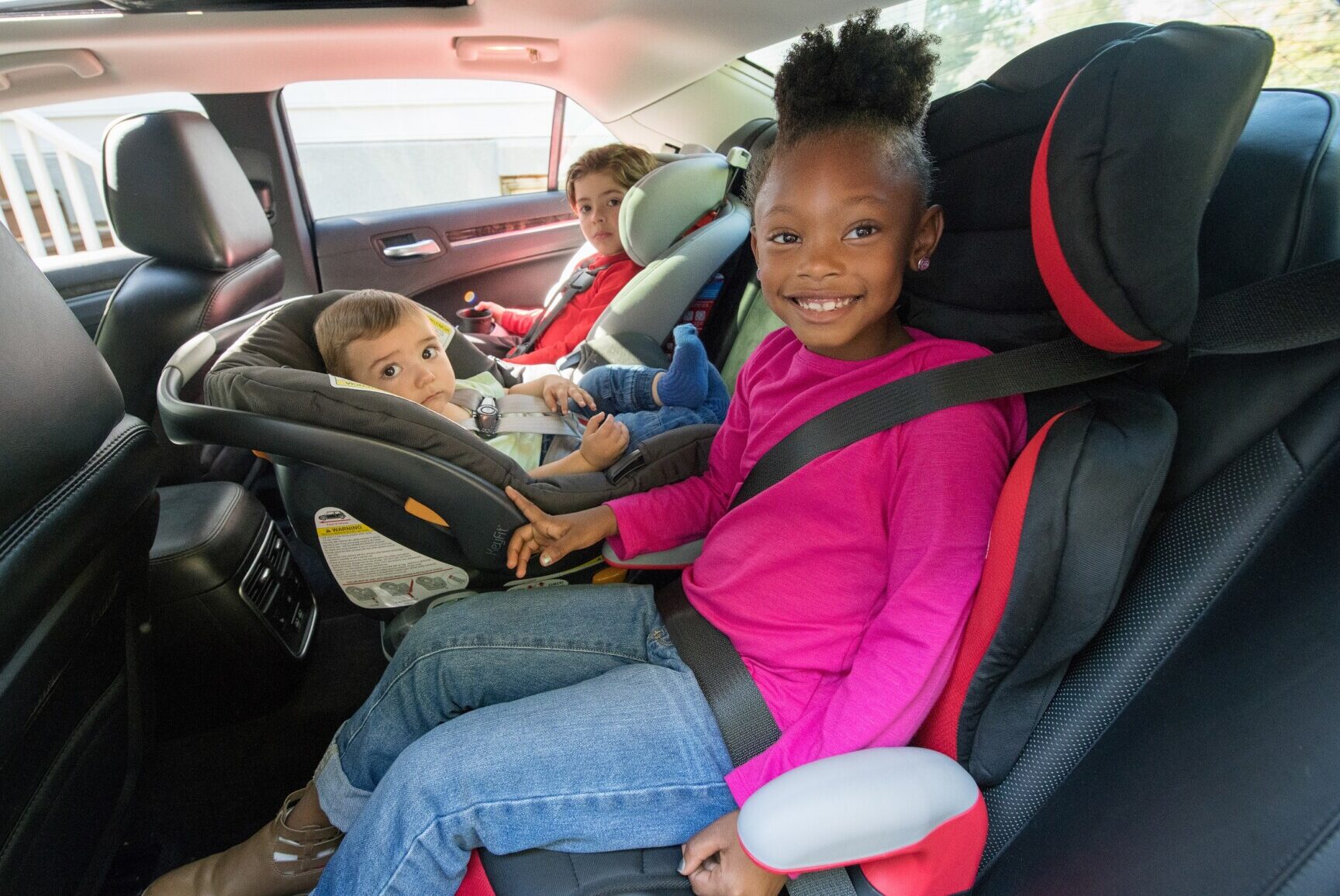
![]()
![]()
![]()
![]()
![]()
Don’t Believe Everything You Read on the Internet.
You know the saying that if you repeat an untruth enough times, it becomes the truth? In some ways that might explain the rash of myths that circulate in parenting and car seat groups on a regular basis. If you repeat something often enough, it starts to morph into a “fact”. It seems like this is especially prevalent lately whenever the subject of 3-across or side-by-side car seat installations comes up.
Since we’ve spent all month busting car seat safety myths, we knew it was critical to help set the record straight on these thorny issues.
Myth: Car Seats Can’t Touch. No “Puzzling”. No Sharing of Imaginary “Airspace”.
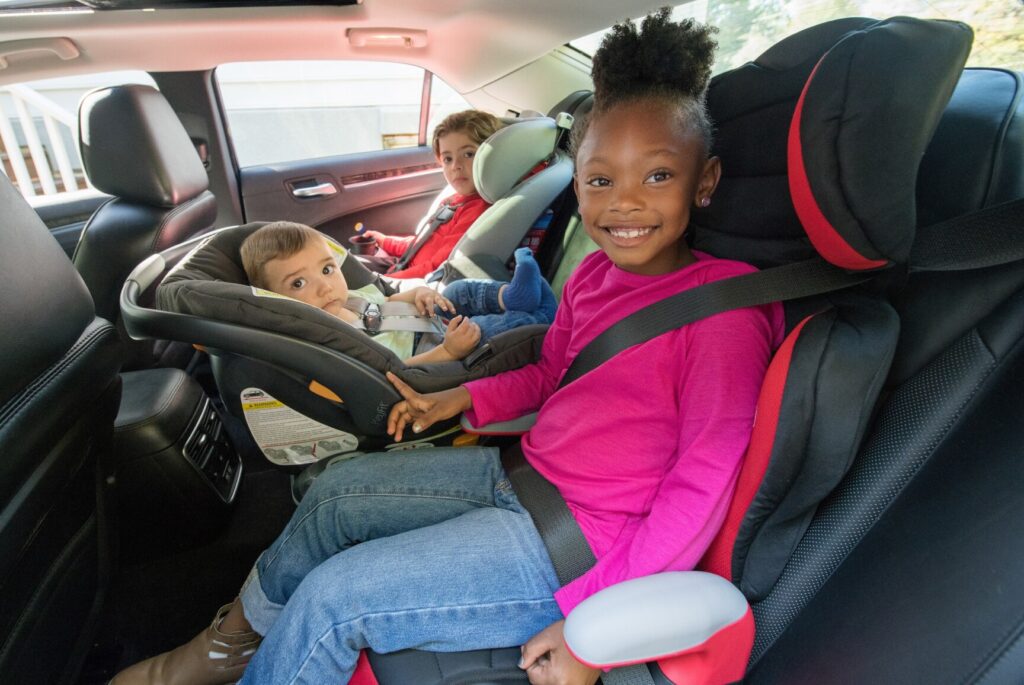
Photo Credit: NHTSA Image Library
Seats touching and/or “sharing airspace” has been a hot topic lately within the online CPST community. The messages circulating lately have been very hardline. No touching allowed, no puzzling of seats, no sharing of imaginary “airspace” allowed, period.
These hardline messages, although probably well-intentioned, assume a level of privilege that not everyone has. When working with families online or in-person, it’s important to understand that parents or caregivers may have different economic, educational, and environmental conditions than you do.
The vast majority of families looking to cram 3 car seats into their backseat cannot simply buy a larger vehicle to better suit their growing family. Even if they could, the lack of inventory right now might make that near impossible. The cost of one or more new car seats, while much less than the cost of a new vehicle, is also out of reach for many families. A CPST should never assume that every family looking for help trying to fit 3 car seats in their backseat has the means, or the desire, to buy new car seats.
The reality is that when there are too many nit-picky “rules” and too many suggestions that you need to buy something other than what you already have, that can be counterproductive. At some point, it becomes a disservice to parents and caregivers who are just trying to keep their kids safe in the backseat using the child restraints that they already own.
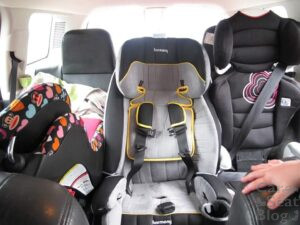
Let’s begin our mythbusting quest by looking at information that can be supported by one or more of the following:
a) The Child Restraint Instruction Manual or Manufacturer’s Website
b) The Vehicle Owner’s Manual
c) The Current CPS Technician Certification Curriculum
d) Common Sense
1. Only install car seats and boosters in seating positions that are approved in the vehicle owner’s manual. Most modern vehicles allow for car seats and boosters to be secured in any of the rear seating positions (driver-side outboard/center/passenger-side outboard) but there are some exceptions so check your vehicle owner’s manual to be sure. Additionally, the vehicle owner’s manual will explain things like the presence and location of lower LATCH Anchors, top tether anchors and how your seatbelts lock to properly secure a car seat. Source: Vehicle Owner’s Manual
2. Each harnessed car seat (rear-facing or forward-facing) must be installed properly as described in the instruction manual and each must be independently secure. As long as each harnessed seat is installed correctly using either seatbelt or lower anchors (with tether when applicable), and the seat does not move more than 1” from side-to-side or from front-to-back when you check for tightness at the beltpath, it meets these criteria. Source: CR Instruction Manuals; Child Passenger Safety Technician Certification Curriculum
3. If using an infant car seat with a base (aka, a rear-facing only seat), you must ensure that the carrier can be properly and securely attached to its base without interference from adjacent car seats. To clarify – there might be a little bit of touching or puzzling with the seat(s) next to the infant seat but you have to be able to securely attach and detach the infant seat from the base. If an adjacent car seat impedes your ability to securely connect the carrier with its base, clearly that is NOT okay. Source: Common Sense
4. Do not double-up on lower LATCH anchors. Only one lower anchor connector is attached to any one lower anchor bar in the vehicle. Source: CR Instruction Manuals; Child Passenger Safety Technician Certification Curriculum; Vehicle Owner’s Manual
5. If using a booster seat or just the adult seatbelt – the seatbelt buckle must be accessible so the child or an adult is able to actually buckle it. Source: Common Sense
6. You can shut both car doors without bending the plastic child restraint shell(s) or shifting the position of the car seats or boosters in the backseat. Source: Common Sense
With that said, it’s important to acknowledge that there are plenty of situations where getting 3-across or 2 seats side-by-side just won’t work.
Getting 3-across in a small car or compact SUV is very difficult and often downright impossible. No one is suggesting that anyone endorse a 3-across setup that clearly doesn’t meet the criteria listed above.
A perfect example is my 2016 Hyundai Tucson which is a small SUV. Getting 3 across with traditional carseats or boosters in this vehicle would be very challenging, if at all possible. The center seating position in this vehicle is barely wider than the fold-down armrest in that position.
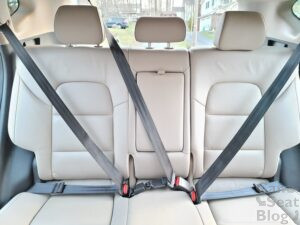
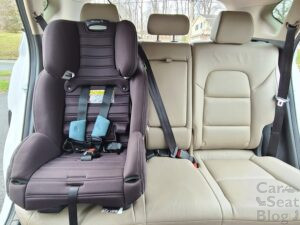
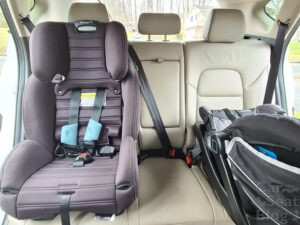
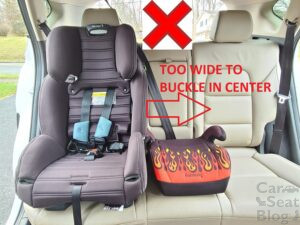
In a mid-size to large sedan or SUV, you’re going to have more room (usually) in that center seating position. Typically, it’s that center seat that makes it or breaks it for 3-across or adjacent car seat installations. But even in a large SUV or sedan, it still won’t be easy and it’s still going to take some trial and error to figure out what actually fits and installs properly. For tips on making the impossible, possible – see our Tips for Successful 3-Across article.
The key to making this setup work in any vehicle is often found in the contours of the car seats and booster. Finding seats with contours/edges that mesh well with the contours/edges of the adjacent car seat or booster is frequently referred to as “puzzling”. Some amount of puzzling is usually required unless you drive a full-size crew cab pickup truck.
And this is where things can get a little… gray.
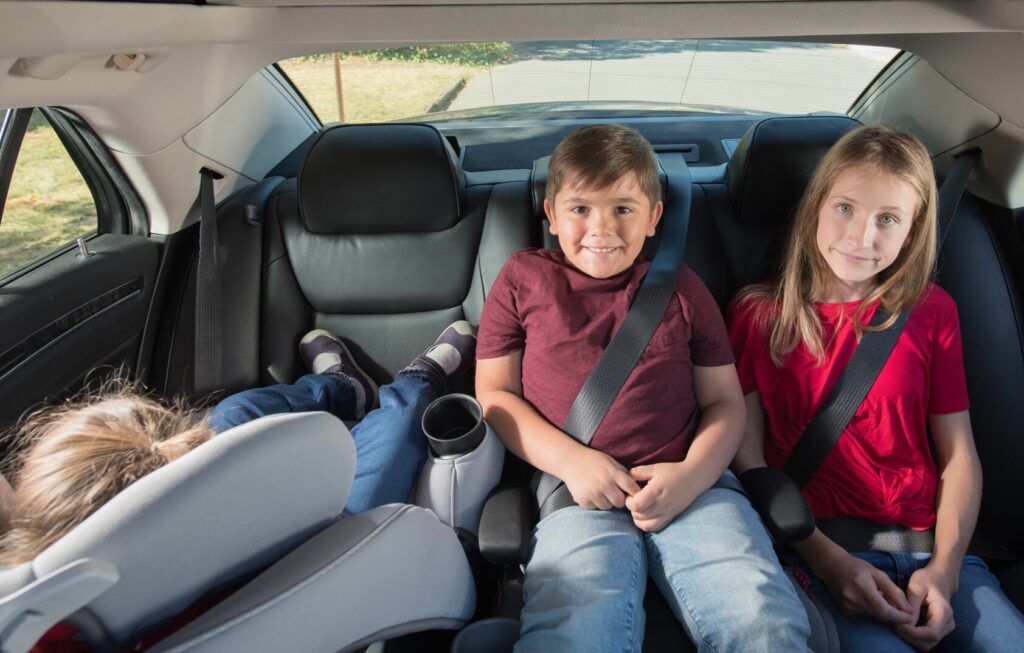
Photo Credit: NHTSA Image Library
The photo above is NHTSA’s photo from their public image library. The photo clearly shows some contact between the outboard rear-facing car seat and the booster seat in the center. The biggest concern in a situation like this would be making sure that the seatbelt buckle is accessible so the child in the booster (possibly with some help) is able to buckle and unbuckle it. Since we don’t know for sure that the buckle isn’t accessible, let’s assume that it is.
Is this “ideal”? Maybe not. Is it “Good” or “Better”? Absolutely. Are these kids safely restrained, in the back seat, using appropriate restraints for their age, weight and height? Yes. Will these kids be very well protected in a crash? Again, the answer is yes.
So why all the fuss lately about car seats touching and puzzling and “sharing airspace”? Based on their own photos, it’s safe to assume that NHTSA (the mother of all things child passenger safety related) doesn’t have a problem with what’s being depicted in their own photoshoots.
Now, let’s look for evidence to support the “No Touching”, “No Puzzling” or “No Sharing Airspace” messages.
Nothing. Nada. Zilch.
I checked the Instructor Guide for the CPS Technician Certification Curriculum and it’s completely silent on the issue of adjacent car seat installations.
I checked manuals for every major car seat manufacturer. The only manufacturer to address 3-across or adjacent car seat installations in their manuals was Graco – and that was just the SlimFit3 LX manual. A 3-in-1 car seat which was designed specifically for this type of situation. Nothing in the Graco SlimFit 3 LX manuals state that car seats can’t touch or puzzle or share airspace.

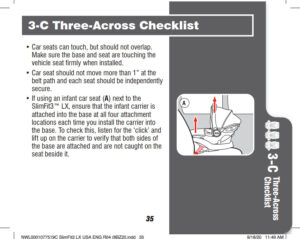
Graco also has a great video with some good advice on 3-across installations with SlimFit3 LX here.
I checked the FAQ section of the major car seat manufacturers. The only website that I found that addressed this in their FAQ section was Diono who stated that “Diono allows our seats to touch each other as well as other manufacturer’s seats”.
So, where did these “rules” come from?
Honestly, I have no idea. I tried to research the origins of these popular online myths about touching and puzzling and air space but I couldn’t find an original source for any of it. My best guess is that it’s just something that someone decided was “a thing” and then it was repeated often enough that it started to sound like a legitimate issue.
The other possibility is that these hardline interpretations are a result of some official language or guidance being misinterpreted by a person or group of people. While there is no proof to support this theory, I think it’s entirely possible.
Some of the words that we use to describe how seats fit next to each other can be very subjective. The word “overlap” is a good example. A little bit of puzzling (but each seat is still properly secured) isn’t what I consider overlapping. If seats were truly overlapping, you wouldn’t be able to get a proper installation and subsequently each seat would NOT be independently secure.
This seems like a good time to remind CPS Technicians and Advocates of the “Good, Better, Best” guidance in the current CPS Technician Certification Curriculum.
The situation can’t always be ideal. “Better” or “Good” is also acceptable and kids will be very well protected in any of these good or better scenarios. Less than ideal does not automatically equal UNsafe. Contrary to popular beliefs, perfection isn’t a necessary component of keeping kids safe in vehicles.
I understand the desire to go to the ends of the earth to make sure our children are protected from injury in motor vehicle crashes. As a mom, a CPST-I, and a survivor of two severe crashes, I totally get it. But it’s important to keep in mind that we can keep kids safe AND also be reasonable in our advocacy efforts.
When we set the bar too high because we’re so passionate about our perceptions of BEST-Best-Practice we actually create barriers to the objectives that we’re trying to achieve. Real life can’t always be ideal. In fact, it’s rarely ideal. If we get too nit-picky about what is and isn’t acceptable, that’s going to have the unintended consequence of more children being moved into the front seat and/or moving out of child restraints prematurely.
Since I wasn’t able to cite a single credible source for any of these 3-across myths, we declare them officially BUSTED!
To be honest, 3-across may not be ideal under dynamic crash conditions. We’re not trying to make anyone feel bad about their need for 3-across or side-by-side child restraints, we’re just pointing out that crashes and subsequent interactions between child restraints and occupants of any size during the crash are unpredictable. More seats + more occupants = more variables.
But unless a family is willing to sell one or more of their kids to a band of roving minstrels*, they may have to make do with what they have to work with. The CPST and advocate community can best support families and caregivers by providing helpful, unbiased and accurate information along with a level of understanding that not every situation is going to be a picture-perfect professional marketing image.
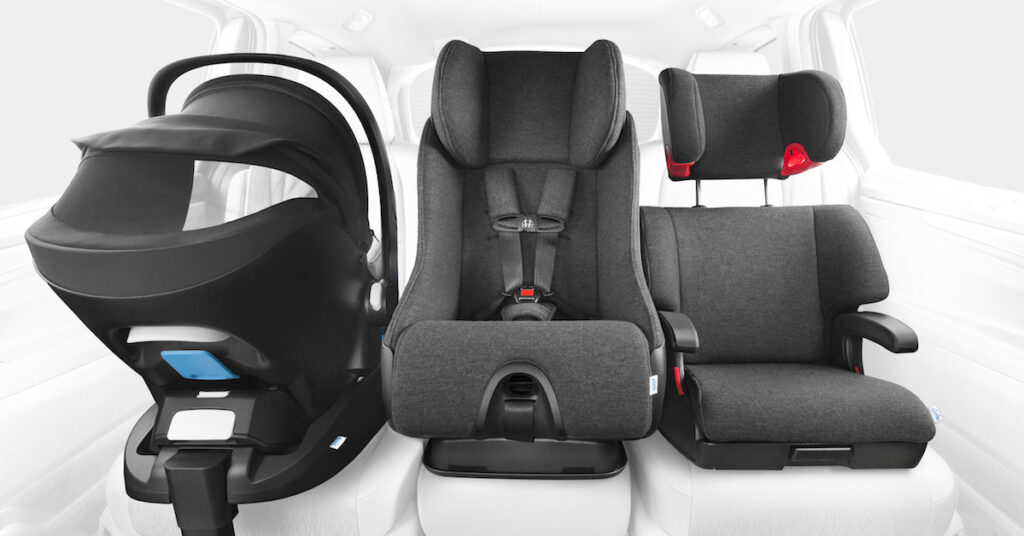
Picture-perfect professional marketing image 😀 Photo Credit: Clek
*I’m always open to new information and different perspectives. I hope this article inspires others to do the same.






